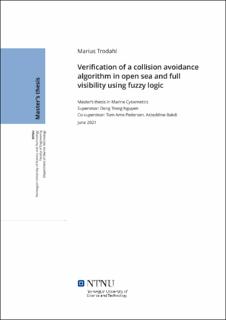| dc.description.abstract | Autonome overflatefartøy er er et populært emne som det er blitt gjort mye forskning på. Ved bruk av autonome overflatefartøy kan man redusere kostnader, øke sikkerhet, pålitelighet, effektivitet og oppnå et mer bærekraftig fartøy. Det høyeste nivået av autonome systemer kan ta valg selv. Om et system ikke er testet og verifisert på en optimal måte, kan det føre til fatale konsekvenser, f.eks. kollisjon med et annet fartøy, grunne eller en kai. For å kunne stole på det autonome systemet er det viktig å teste og verifisere systemet. Kollisjonsunngåelsessystemet er en kritisk del av kontrollsystemet som må bli testet og verifisert, men det er fremdeles vage regler og utilstrekkelige metoder for testing og verfisering av denne delen. Derfor fokuserer denne oppgaven på å evaluere COLREGs samsvar, som er sentral i opptredende verifikasjon og sikkerhetstesting av kollisjonsunngåelsessystemet.
Arbeidet utført i denne oppgaven er motivert av mangelen i litteraturen på evaluering av kollisjonsunngåelsessystemet i en score for møter mellom flere fartøy i henhold til COLREGs. Metoden utført i oppgaven benytter seg av fuzzylogikk ettersom at fuzzylogikk kan håndtere vage beskrivelser og representere språklige variabler og verdier slik innholdet i COLREGs er. Dette gjør også at COLREGs blir implementert på en dataspråklig måte i en kvantitativ matematisk form, uten å innføre antagelser eller spesifikasjoner til originale COLREGs. Målet med oppgaven er å utvikle systemer som kan evaluere kollisjonsunngåelsessystemet i henhold til COLREGs. Systemene som er utviklet i denne oppgaven er delt inn i 3. Det første utviklede systemet evaluerer COLREGs samsvar med et utført scenario i henhold til hvordan OS og TS samarbeidende oppfører seg for å unngå kollisjon. Dette systemet er betegnet som obj. 1. Det andre utviklede systemet evaluerer OSs oppførsel i henhold til COLREGs, betegnet som obj. 2. Begge disse evalueringssytemene kan evaluere COLREGs samsvar med flere fartøy, det vil si når det er flere TS enn ett, og er betegnet som obj. 3.
Obj. 1 bidrar til å se hvordan fartøyene skal oppføre seg i et scenario for å oppnå COLREGs samsvar. I testing og verifisering av kontrollsystem bryr Klassifiseringsselskap seg kun om OSs oppførsel, derrav obj. 2. Med disse systemene kan man finne utfordringene i et scenario med obj. 1 for så å teste kontrollsystemet til OS med samme scenario med obj. 2. F.eks. vil et scenario hvor TS ikke følger COLREGs være en god test for OSs kontrollsystem.
De utviklede evalueringssystemene er testet og verifisert på flere simulerte scenarioer, ved å benytte fuzzylogikk til å implementere COLREGs på en dataspråklig måte og deretter evaluere COLREGs samsvar med obj. 1, 2 og 3. De oppnådde resultatene viser at å benytte fuzzylogikk gir gode muligheter. Resultatene er validert gjennom sammenligning av de utviklede evalueringssystemenes resultat og visuell analyse av Nord-Øst, retning og hastighets plot. | |
| dc.description.abstract | Autonomous Surface Vehicles (ASV) have been a subject undergoing intense study. The autonomy provides good potential regarding reducing the cost, increasing safety, reliability, efficiency and sustainability. The highest level of autonomous system is able to make decision itself. If the system is not tested and verified at an optimal manner it could lead to fatal consequences, e.g. crashing into another vessel, grounding or colliding with a quay. Therefore, testing and verification of the autonomous system needs to be performed to obtain trust, where the Collision Avoidance System (CAS) is a critical part of the control system. However, there are still vague rule sets and inadequate methods for testing and verification. This work focuses on evaluating COLREGs compliance which is central in performance verification and safety testing due to the central role of COLREGs.
The work conducted in this thesis was motivated through the lack in the literature of evaluation of a CAS in one metric for multi vessel encounters in regard to COLREGs. The approach utilizes fuzzy logic as this method could handle vague terms, could represent linguistic variables and values written in COLREGs in a quantitative mathematical form without introducing sharp assumptions or specifications to original COLREGs. The goal is to develop evaluation systems to test and verify the CAS in regard to COLREGs, and it is broken down into three objectives. The first system developed system, denoted as obj. 1, evaluates the COLREGs compliance of a finished scenario in regard to how OS and TS cooperatively behaved to evacuate the situation and avoid risk of collision. The second evaluation system, denoted as obj. 2, focuses on evaluating the COLREGs compliance of how the OS behaved in a situation with a risk of collision. Both pairwise evaluation systems, obj. 1 and obj. 2, are then extended to evaluate the compliance in multi vessel encounter scenarios in the third objective, denoted obj. 3.
Obj. 1 contributes to verifying how vessels should behave in a scenario to obtain COLREGs compliance. In testing and verification of a control system, Class societies only consider the OS, therefore obj. 2. With these systems obj. 1 could be utilized to determine what challenges are in the provided scenario, and then utilize this scenario to evaluate OSs compliance, i.e. obj. 2, e.g. a scenario where TS does not comply to COLREGs would be great to test the OSs control system on.
The designed systems are verified on a set of simulated scenarios, utilizing fuzzy logic to firstly incorporate COLREGs in a computational algorithm, machine-executable software form and secondly evaluate COLREGs compliance for obj. 1, 2 and 3. The obtained results are validated against visual assessment of the North-East trajectory, heading and speed plots, where the evaluation systems provided variables that would be challenging or impossible to obtain by visual assessment. | |
